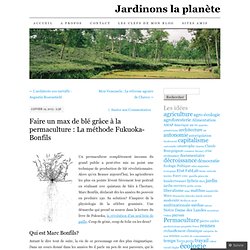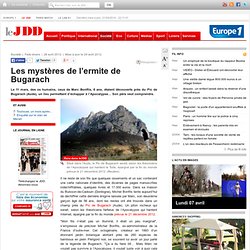

Plans à tester. Wiki MarcBonfils : Transcription Coopérative. Faire un max de blé grâce à la permaculture : La méthode Fukuoka-Bonfils. Un permaculteur complètement inconnu du grand public a peut-être mis au point une technique de production de blé révolutionnaire.

Alors qu’en Beauce aujourd’hui, les agriculteurs les plus en pointe lèvent fièrement leur poitrail en réalisant 100 quintaux de blés à l’hectare, Marc Bonfils, déclarait dès les années 80 pouvoir en produire 150. Sa solution? S’inspirer de la physiologie de la célèbre graminée. Une démarche qui prend sa source dans la lecture du livre de Fukuoka, la révolution d’un seul brin de paille. Les mystères de l’ermite de Bugarach. Paru dans leJDD Situé dans l'Aude, le Pic de Bugarach serait, selon les théoriciens de l’Apocalypse qui hantent la Toile, épargné par la fin du monde prévue le 21 décembre 2012.

(Reuters) Il ne reste de son fils que quelques ossements et un sac contenant une carte nationale d’identité, des dizaines de pages manuscrites indéchiffrables, quelques livres et 17.000 euros. Bonfils forum brin de paille.
Affiche. Mulch vivant, gros talage. Cours audio de Marc Bonfils en téléchargement. Page en cours de rédaction Voici les enregistrements audio de 2 stages donnés par Marc Bonfils, le premier du 1 au 4 mai 1986 à Minzier en Haute-Savoie, et le second les 16 et 17 juillet 1986 à Bouriège dans l'Aude.

Ces cours avaient été enregistrés en direct sur cassettes audio par un des stagiaires, Émile Moné. Nous le remercions de nous les avoir transmises (en 2008, si je me souviens bien). Ces cassettes ont été ensuite bénévolement digitalisées en 2009 par Freda et Pedro de l'éco-site Crocus à Jupilles, que nous remercions pour cette aide. Autorisations et éthique. M. Bonfils 1986s. Sol se rétablit, grâce à l’a bondance de la biomasse déchétuaire qui est produite.

Et en permaculture on essaiera d’imi ter ce processus plutôt que celui-là.Une énorme perte, en plus dans ce système de cultu re, c’est un énorme gaspillage,c’est l’énergie solaire par exemple. Recherches Bonfils.pdf. Attention perles Francophones et Anglophones. Nat Ag Winter Wheat in N Europe by Marc Bonfils. Cover crops. Posted January 29, 2004: In no-till cover crop systems, the known benefits of cover crops are maximized by allowing them to grow until shortly before planting the vegetable or other cash crop, and by managing the cover crop without tillage.

The best cover crops for this purpose have the following characteristics: They produce a lot of biomass, at least 3 tons above-ground dry matter per acre. They are readily killed by mowing, rolling or other mechanical means, forming a mulch or they are reliably winter-killed, leaving a mulch for spring no-till planting, or they die down naturally in time to plant summer vegetables. Their residues are sufficient to provide effective weed control in the subsequent vegetable crop. They provide habitat for natural enemies of vegetable crop pests. Adding Cover Crops to a No-Till System / Videos from the Field / Multimedia. Dan Forgey, farm manager at Cronin Farms in South Dakota, has been using no-till management for more than 17 years.

Over that time, Forgey has developed a keen understanding of how his farming system works and where new challenges and opportunities exist. Several years ago, Forgey began thinking about how he might include cover crops on the 8500-acre farm to improve soil and the bottom line. Fukuoka-Bonfils winter wheat method for chicken feed. "My big question is: what would be the variety of wheat of choice?

" I think your choice would be determined by what varieties grow best in your climate, and what the final use would be. Here is the list of Washington 2009 Preferred Winter Wheat Varieties: One site said that hard winter wheats are generally high in protein, averaging 13-15%, and the soft white wheats tend to be lower in protein, averaging 11-12%. Since protein levels are important to egg production, a lower protein level might have to be compensated for elsewhere in the diet. The third issue would be sourcing what you decide on. If I understand the Bonfil method correctly, he only plants a maximum of four seeds per square meter/yard. The last paragraph of the article you linked mentioned that "A problem of the wheat-clover association is that the wheat grows too tall because of the richness in soil Nitrogen.
How to grow winter wheat? The Fukuoka-Bonfils method. The author has experimented with alternative cultural measures for the production of winter wheat in the region of Beauce, France. Over the years, he has developed a system that embraces the general principles of permaculture. Although Bonfils' method is primarily for wheat, it is easily adaptable for other cereals.
Bonfils found a way a growing food wothout ploughing in the European climate, as Masanobu Fukuoka did in Japan. LEISA Magazine • 16.4 • December 2000 Tillering in grain crops can be enhanced to increase production. Winter wheat is normally sown in September-November and grows just a little before going dormant in winter. There are a number of drawbacks in growing winter wheat the conventional way. Fukuoka-Bonfils grain cultivation method. Fukuoka-Bonfils grain cultivation method The method Fukuoka-Bonfils is a natural method of cultivation of winter cereals, which its authors, Masanobu Fukuoka, and Marc Bonfils, watched from nature.

It is based on the knowledge of soil functions, the life cycle of cereals and their mutual relations. The life cycle of cereals consists of 2 phases, time-bound solstice. Since the summer solstice (21.6.) until the winter solstice the vegetation phase takes place, which Marc Bonfils called touch and is characterized by the shorter days. In a prolonged period of days, from the winter solstice (21.12.) until the summer solstice the reproductive phase takes place, which the M. The procedure for growing grains by this method differs from conventional breeding in particular on four points: A) adoption of no system - land to cultivate is not plowed or otherwise, firstly crops grow a carpet of creeping clover (Trifolium repens) and then corn is planted into it. Source:
Bonfils-Winter_Wheat_Physiology. Bonfils-Winter_Wheat_Physiology. Les meilleurs blés - Vilmorin Andrieux et Cie (1880) - Table des matières.